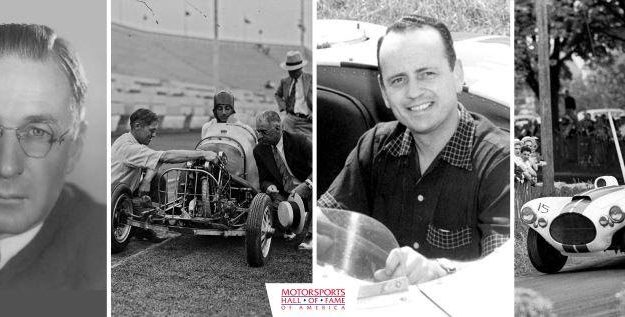MONTEREY, Calif. — Earl B. Gilmore and Phil Walters, aka “Ted Tappett,” will join the Motorsports Hall of Fame of America Class of 2024 in the Historic Category.
Gilmore and Walters join seven other members of the Class of 2024 who were announced in April at the Acura Grand Prix of Long Beach:
Austin Coil (Drag Racing), Scott Dixon (Open Wheel), Jim Downing & Dr. Robert Hubbard (Technology), Bud Ekins (Motorcycles), Jimmie Johnson (Stock Cars), Paul Newman (At Large) and John Surtees (Sports Cars).
The 36th Annual MSHFA Induction Celebration Presented by Toyota Racing will take place March 11 – 12, 2024 in Daytona Beach, Florida.
The Historic Category is for nominees whose main motorsports achievements occurred prior to 1960. Induction is decided by a straight vote among 40+ historians, authors and experts.
“Gilmore and Walters represent the very best of American motorsports,” said Motorsports Hall of Fame of America President George Levy. “We look forward to bringing their timeless, uniquely American stories and values to new generations.”
Earl Bell Gilmore (1887 – 1964)
Gilmore was the scion of the Los Angeles-based Gilmore Oil fortune. A brilliant promoter, the Stanford grad felt motorsports was an excellent way to promote his company’s products. He was right. Air racing great Roscoe Turner (MSHFA Class of 1991) barnstormed the country in his Lockheed “Gilmore Lion” complete with an actual lion cub named Gilmore riding second seat. It made the regional oil company a household name across America.
A big supporter of open wheel racing, his 18,000-seat Gilmore Stadium, which he built in 1934, has been called the world’s first purpose-built midget racing facility. In its heyday it sold out regularly, greeting more than five million spectators over its 16-year lifespan.
They got to see stars and future Motorsports Hall of Fame inductees like Rodger Ward (MSHFA Class of 1995), Bill Vukovich (MSHFA Class of 1992) and Sam Hanks (MSHFA Class of 2000) up close on a regular basis. Gilmore-sponsored cars also won the Indianapolis 500 twice (1935, 1937) and set numerous land speed records in the hands of inductees John Cobb (MSHFA Class of 2021), Ab Jenkins (MSHFA Class of 2023) and Sir Malcolm Campbell (MSHFA Class of 1994).
Gilmore also played a crucial role in the development of the Offenhauser engine that dominated IndyCar racing for decades. Unaccepting of the often-unreliable engines that powered most midgets when Gilmore Stadium opened, Gilmore commissioned Fred Offenhauser (MSHFA Class of 2002) and Leo Goossen to produce a reliable 97 cubic inch race motor. That order kept Offenhauser afloat and led directly to the larger versions that between 1935 and 1976 won 27 Indianapolis 500s. The first victory for an Offy at Indy was in 1935, when Kelly Petillo topped the field in his “Gilmore Speedway Special.”
A civic-minded son of a farmer, Gilmore’s legacy also includes the establishment of a well-known Los Angeles landmark and tourist attraction. Gilmore started the world-famous and original LA Farmers Market in 1934 and it continues to thrive today.
Philip F. Walters (1916 – 2000)
Walters began his career with a ruse. Wanting to break into racing at 22 but short of funds and experience, he bought a helmet and roamed the paddock at local midget tracks where he claimed he was fictitious West Coast star “Ted Tappett.” It worked. He got a ride and started winning immediately. At one point in 1940 he won 26 of 35 features. The following year he scored 21 firsts, 16 seconds and four thirds. One of his biggest fans was a young New York teenager named Dan Gurney, a member of the MSFHA’s Class of 1991.
During World War II, Walters’ fame may have saved his life. He volunteered to be a glider pilot, an incredibly dangerous assignment. In the aftermath of Operation Market Garden, badly wounded and losing a lot of blood, the doctors in the German hospital he was taken to were inclined to save what little plasma they had for prisoners more likely to survive. Then, one of them recognized Walters from a trip he had taken to Philadelphia before the war. He’d gone to the races and been mesmerized by his talent. He refused to let “Ted Tappett” die.
After the war, missing a kidney and part of a lung, Walters continued his astonishing run of success in midgets. Over time, he partnered with Bill Frick to create the Cadillac-powered “Fordillac” hot rods and race cars. Then, wealthy sportsman and inductee Briggs Cunningham (MSHFA Class of 1997) invited him to join an American expedition to Le Mans.
The Cadillac they drove, nicknamed Le Monstre, was hugely popular, but just a precursor. Soon Walters and Frick were helping Cunningham design and develop his own cars, which Walters drove to a number of major victories, including two at Sebring (1953, 1955) in three tries and two in the Watkins Glen Sports Car Grand Prix (1951, 1954) in three attempts.
Though Walters was nearing 40, his singular talent persuaded Enzo Ferrari to offer him a contract for the 1955 season, which would have made him the first American to drive F1 full-time for the Scuderia. It would never be fulfilled. Walters had agreed to one final attempt at Le Mans with Cunningham. He had finished third in 1953 — Cunningham’s best-ever finish there – and was just behind the leaders in a Cunningham D-Jag in the 1955 race when the Mercedes of Pierre Levegh launched into the crowd. Over 80 spectators were killed, and Walters had seen enough.
“At that moment, I decided to retire from racing,” Walters told Vintage Motorsport years later. “Drivers getting killed is one thing — but women and children?”
